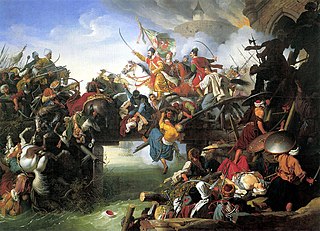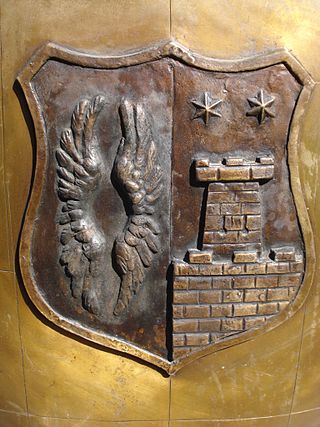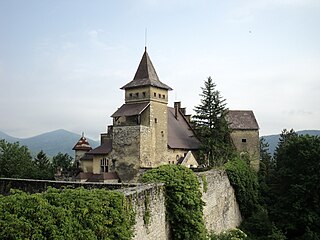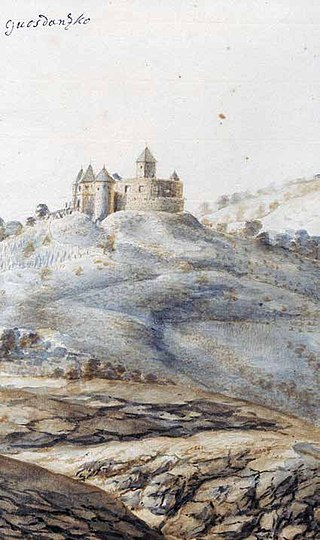
Nikola IV Zrinski or Miklós IV Zrínyi, also commonly known as Nikola Šubić Zrinski, was a Croatian-Hungarian nobleman and general, Ban of Croatia from 1542 until 1556, royal master of the treasury from 1557 until 1566, and a descendant of the Croatian noble families Zrinski and Kurjaković. During his lifetime the Zrinski family became the most powerful noble family in the Kingdom of Croatia.

Bihać is a city and the administrative centre of Una-Sana Canton of the Federation of Bosnia and Herzegovina, an entity of Bosnia and Herzegovina. It is situated on the banks of river Una in northwestern Bosnia and Herzegovina, in the Bosanska Krajina region. In 2013 its population was 56,261.

The siege of Szigetvár or the Battle of Szigeth was a siege of the fortress of Szigetvár, Kingdom of Hungary, that blocked Sultan Suleiman's line of advance towards Vienna in 1566. The battle was fought between the defending forces of the Habsburg monarchy under the leadership of Nikola IV Zrinski, former Ban of Croatia, and the invading Ottoman army under the nominal command of Sultan Suleiman the Magnificent.

The House of Zrinski or Zrínyi was a Croatian-Hungarian noble family, a cadet branch of the Croatian noble tribe of Šubić, influential during the period in history marked by the Ottoman wars in Europe in the Kingdom of Croatia's union with the Kingdom of Hungary and in the later Kingdom of Croatia as a part of the Habsburg monarchy. Notable members of this family were Bans of Croatia, considered national heroes in both Croatia and Hungary, and were particularly celebrated during the period of Romanticism, a movement which was called Zrinijada in Croatia.

Ostrožac Castle (Bosnian) is a castle located in Bosnia and Herzegovina in the Una-Sana Canton just outside the town of Cazin, in the village of Ostrožac. The castle dates back to the 13th century when Ostrožac was part of property of the noble house of Babonić family. In 1592 it was captured by the Ottoman Empire and established as an Ottoman province of Bosnia. The castle was built between 1900 and 1906 by Major of Bihać Lothar Von Berks as a birthday present for his wife, member of the Habsburg family.

Hrvatska Kostajnica, often just Kostajnica, is a small town in central Croatia. It is located on the Una river in the Sisak-Moslavina County, south of Petrinja and Sisak and across the river from Kostajnica in Bosnia and Herzegovina. In the past, Hrvatska Kostajnica was called by different names, Koztainicha, Kaztanicha to Costgnanica. The name most likely comes from the word Kostanj (chestnut).

Novi Grad, formerly Bosanski Novi, is a town and municipality in Bosnia and Herzegovina. Administratively, it is located in the Republika Srpska entity. Situated in the far northwest of the country, it lies across the Una from the Croatian town of Dvor. According to the 2013 census, the town has a population of 11,063 while its municipality comprises a total of 27,115 inhabitants.

Stari Grad is a fortress near the city of Užice, in central Serbia. Today in ruins, it is an example of typical medieval Serbian architecture. Historians believe it was built in the second half of the 14th century to control movement along nearby roads, and the town of Užice. Stari Grad was declared Protected Monument of Culture in 1983, and it is protected by Republic of Serbia. Though in ruins, the fortress is considered a symbol of Užice.

Ozalj Castle is a castle in the town of Ozalj, Croatia.

Hreljin Castle is a fortress and castle near Hreljin, Croatia. It is located in the western part of Vinodol, in the hill above Bakarac, which served as its seaport. Hreljin is first mentioned in historical sources in 1225, when the Frankopan noblemen received it as a gift from the Croatian-Hungarian king Andrew II. It is one of the nine towns that signed the Vinodol Codex, one of the oldest Slavic codes, in 1288. After the Frankopans, it was owned by another noblemen family, the Zrinskis, from 1550 until the execution of Zrinskis and Frankopans in 1671. When Bakar was declared a Royal free city in 1778, Hreljin was under its rule, but already decaying. The last inhabitants were three priests who abandoned it in 1790.

Zrin Castle is a ruined castle located in the village of Zrin, south of the town of Sisak in Dvor municipality, central Croatia.

Zrinski Park is situated in downtown Čakovec, northern Croatia, close to the central square.

Čakovec Castle or Zrinski Castle is a medieval fortification in the middle of the town of Čakovec, the administrative seat of Međimurje County, northern Croatia.

Gvozdansko Castle is a castle in Gvozdansko village, between the towns of Dvor and Glina and not far from Zrin Castle, in Sisak-Moslavina County, central Croatia.

The siege of Gvozdansko was an Ottoman siege of the fort of Gvozdansko in the Kingdom of Croatia in 1577–1578. In the 1570s, the Ottomans intensified their efforts to capture the valley of the Una River. A string of forts along the Una, centred around Gvozdansko and in possession of the Zrinski noble family, formed the main line of defense of Croatia since 1527. The fort held off Ottoman attacks in 1540 and 1561.

The Ostrovica Castle is a large medieval structure situated above the small village of Ostrovica near Kulen Vakuf, Bihać municipality, Bosnia and Herzegovina. Having been built on a heavily wooded ridge of a steep hill overlooking left bank of the shallow Una river, the castle was located on a strategic site connecting the northern and southern parts of the long Una valley.

The Kurjaković family, also known as the Counts of Krbava, were a Croatian noble family that originated from the noble tribe of Gusić. It formed at the end of the 13th century, as descendants of Kurjak. They reached their peak as magnates between mid-14th and mid-15th century, having tight connections and high official positions at the Hungarian royal court, and dissolution in 1531 when the estates of magnate Ivan Karlović went to Nikola III Zrinski. Two members were Ban of Croatia, as well two were founding members of Order of the Dragon.

The House of Orehovečki was a Croatian noble family, descending from Sveti Petar Orehovec in the former Bjelovar-Križevci County, where it had its largest estates, and reached its peak in the 17th century. Thanks to the marriage connections, it was connected to many influential noble families like Keglević, Patačić, Ratkaj, Alapić etc. Notable members of the family were important state officials, military officers, Catholic Church prelates and so on.

Ključ Fortress is a medieval fortress in Bosnia and Herzegovina, above the modern-day town of Ključ. It is located on an elongated slope on high rocks that dominate the valley of the river Sana. Before it was redeveloped, there was a small ancient fortress from Roman times.

Franjo Frankopan Slunjski was a Croatian nobleman from the branched Frankopan family in the 16th century. From 1567 until his death he served as Ban (Viceroy) of Croatia and was one of the most prominent figures of the fight against the Ottoman Turks and their expansion. Having been the last male descendant of the Slunj branch of the Frankopan family, he was called "the Sword and Shield of the Remnants of Illyria".





















